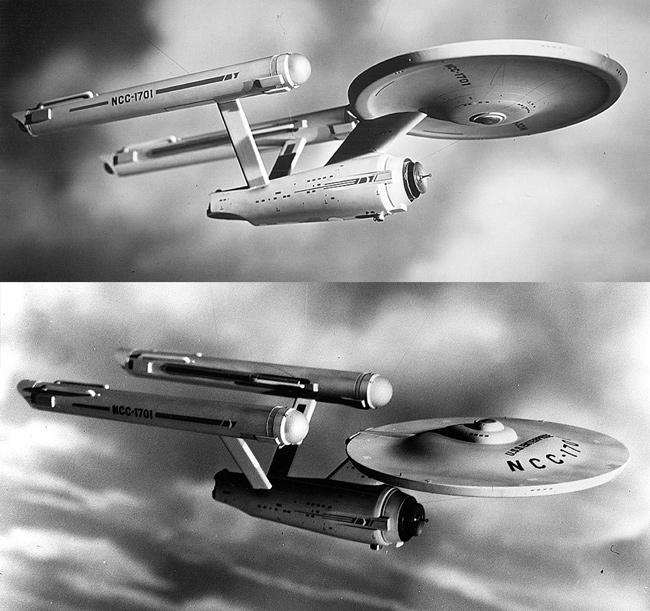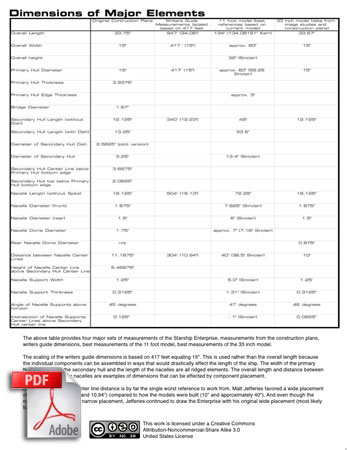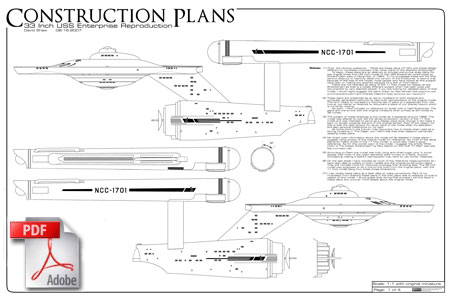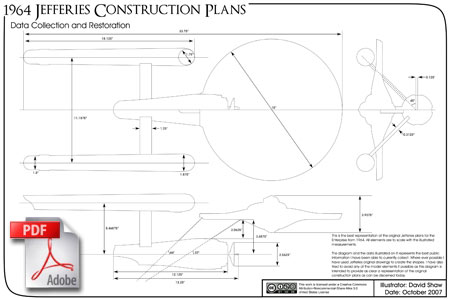 |
|
History of the 33 inch model of the Starship Enterprise
by David Shaw
Introduction  Click to enlarge October 1964: Jefferies had started in on drawing a set of final plans of the Enterprise model. This model was based around a smaller bridge that Jefferies and Guzman saw as similar to the flight deck of a large aircraft or the control room of a nuclear submarine.  Click to enlarge When Guzman left the production, his supervisor at Desilu Studios, Franz Bachelin, took over as art director. Bachelin wanted the bridge to be more cinematic and requested that it include multiple levels. Here is how Jefferies put it... "The split-level bridge was not part of the original idea. I did not like it, and in many ways I do not now." In attempting to comply with Bachelin's request, Jefferies came up with these sketches attempting to shoehorn in this idea into the original size of the bridge structure. 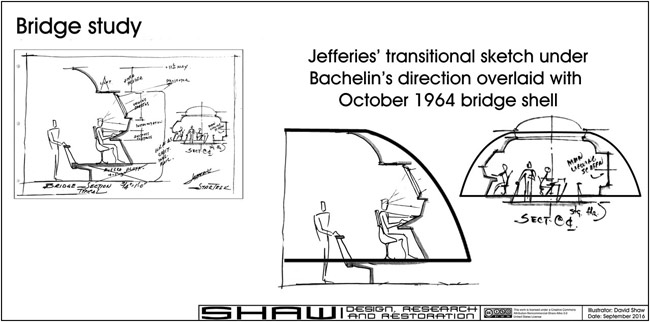 Click to enlarge Bachelin wanted a more expansive bridge, and because the model's basic design had been approved and the studio was in talks with Howard A. Anderson Company about the pilot's effects, the most straight forward solution to the problem was to scale up the Enterprise to accommodate the final bridge design.  Click to enlarge Construction of the bridge set was started and Jefferies began drafting the final set of drawings of the Enterprise model. Nov. 4, 1964 (Wednesday): Richard Datin (via Howard A. Anderson Company) agrees to build an approximate three foot long model based on an early set of plans which give a real world scale of 1:192. If this had been the final drawings, this would have been the 540' version, but the proportions of this early drawing are actually different from the final plans. He also agrees to supervise the construction of the final (4x) large scale model (which would have most likely been 1:48 scale). Datin starts in on building the 33 inch model out of a kiln-dried sugar pine based on these early plans, which include notes on which parts of the plans he could use and which he shouldn't while waiting for the final plans. Datin has said that he contracted out the turning of the larger pieces to a local wood shop. Odds are that the primary hull of the 33 inch model was one of those pieces started before the final plans were finished. Nov. 7, 1964 (Saturday): The final construction plans are finished by Jefferies. These plans include the scale reference of FULL SIZE & 3" = 1'-0" TO LARGE MINIATURE. As the one feature linking the scale of the model to the live action sets is the bridge, the overall size was already determined by this point. In fact because Jefferies didn't want windows or the like on the surface of the ship, the bridge was the primary feature that would be used to sell the size of the ship to the audience in the pilot. This is a reconstruction of the plans given to Datin of the Enterprise... 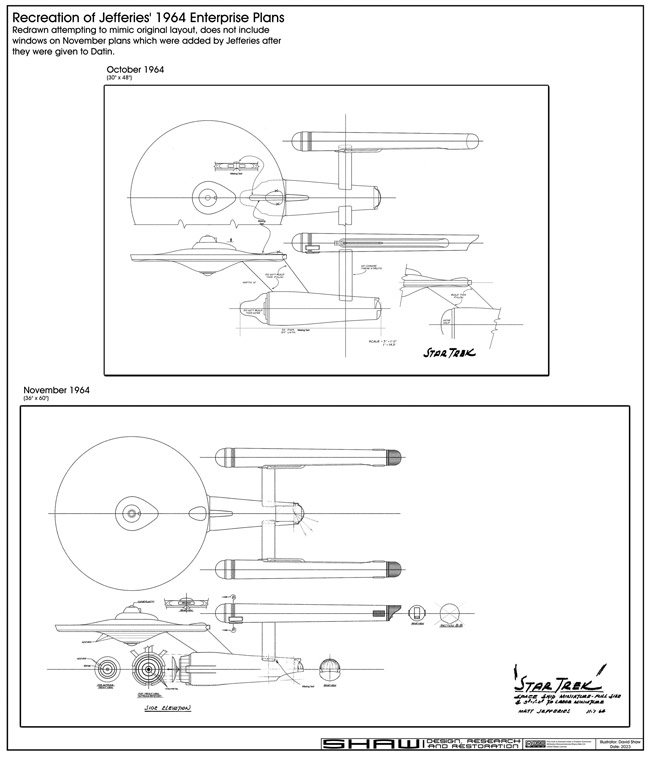 Click to enlarge Nov. 8, 1964 (Sunday): Datin receives the final plans.. This date needs to be double checked. The drawings are labeled November 7th and I'm assuming he got the drawings within 24 hours of their completion. Datin's time sheet shows him working continuously on the model starting on the 7th. Nov. 15, 1964 (Sunday): A little more than a week later the 33 inch model is presented to Roddenberry for approval. This is where the request for the addition of exterior windows takes place (which were not part of the original design). The windows seen on the few elements of the original drawings were added after the original completion date of those drawings. My understanding is that Roddenberry was constantly asking Jefferies for more details. Nov. 16 & 17, 1964: Datin noted his work on the 4x Enterprise on these days, which was most likely him making arrangements with Volmer Jensen's Production Models Shop in Burbank about its construction. This is also most likely the time in which Jefferies modifies the plans to include windows for Datin to add to the model (and why Datin didn't start in on the work right after the meeting with Roddenberry). Nov. 18-22, 1964: Datin completes the final detailing of the 33 inch Enterprise. Nov. 23, 1964: Construction begins on the 11 foot (4x) model. Datin provides the 33 inch model along with the plans and notes to Mel Keys and Vern Sion, who are building the Enterprise at Production Models Shop. The details of the 33 inch model are the target for them to match as it now has all the requested/approved changes to the design.  Nov. 27, 1964: Live action shooting is scheduled for the Transporter Room, Enterprise Passageway and Pike's Quarters. 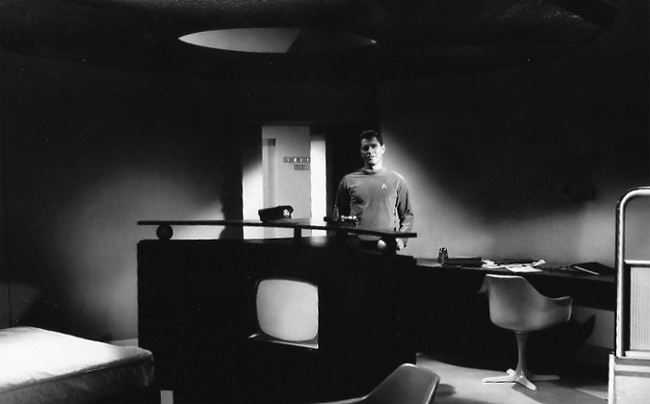 Nov. 30, 1964: Live action shooting is scheduled for the bridge. The bridge design and construction had taken about 6 weeks, so it started in mid October. This day's schedule includes the crane shot of the bridge that will eventually be composited with the (as yet) unfinished 11 foot model.  Click to enlarge Dec. 1, 1964: Live action shooting is scheduled for the Bridge and Orion Courtyard. Dec. 14, 1964 (Monday): The 33 inch model is delivered to Roddenberry while The Cage was being filmed in Culver City (40Acres). This model is used for all effects shots in The Cage except the most important one (the zoom in on the bridge). Images of the model being delivered seem to be on the Rigel Fortress set, but filming was originally scheduled for December 8th for those shoots. Either this date should actually be the 8th or the shooting schedule met with delays. December of 1964 was rainier than normal for most parts of California, so the Rigel Fortress shoots might have been delayed. 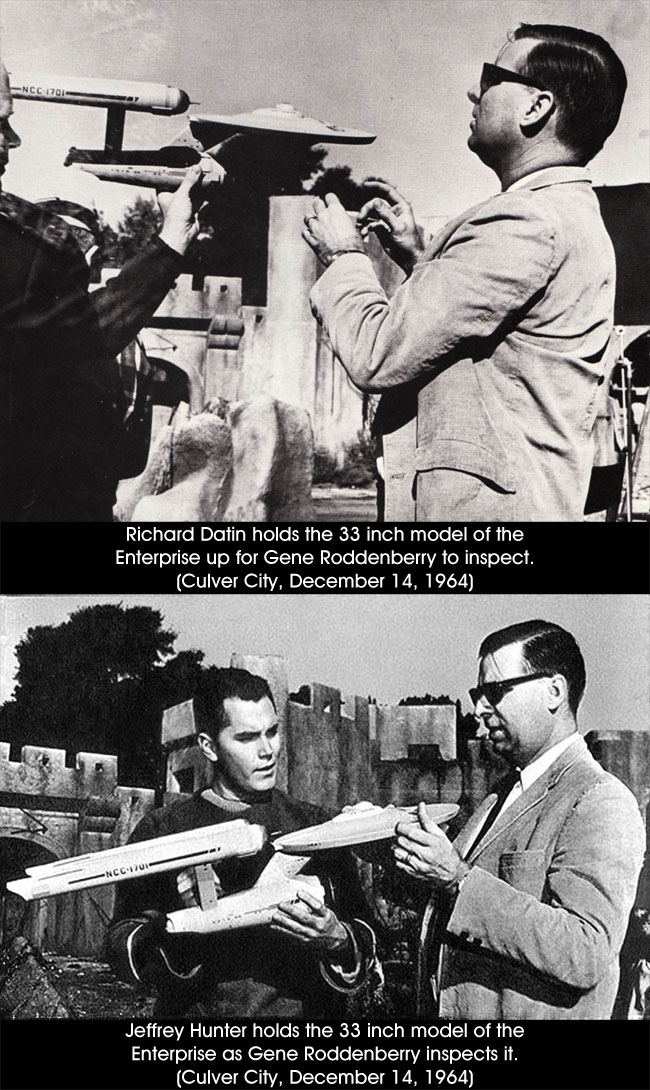 Dec. 24, 1964 (Thursday): Shooting of The Cage wraps, with only one effects shot still outstanding. Part of the budgeting of the pilot included additional model passes to help build up a library of generic shots that the eventual series could draw on. Most of the effects shots of the 33 inch model throughout the original series were shot at this time. 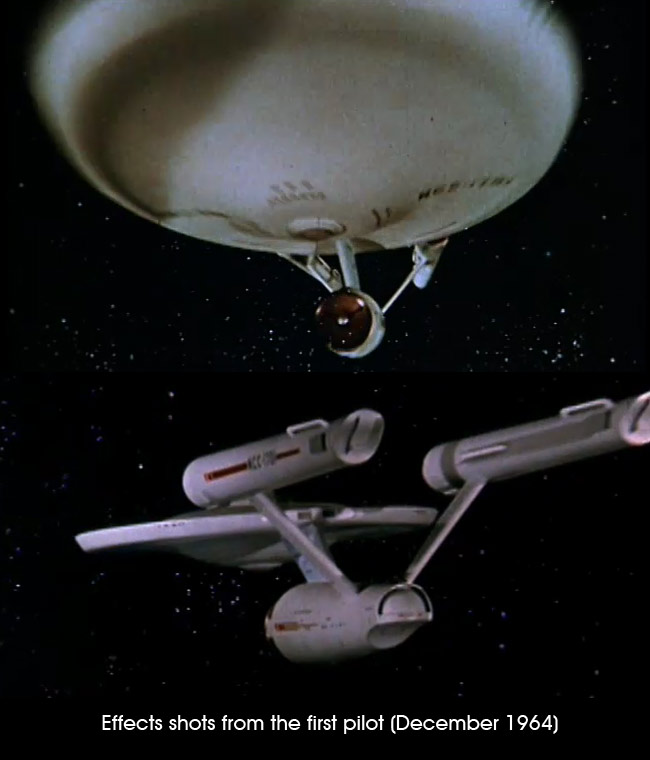 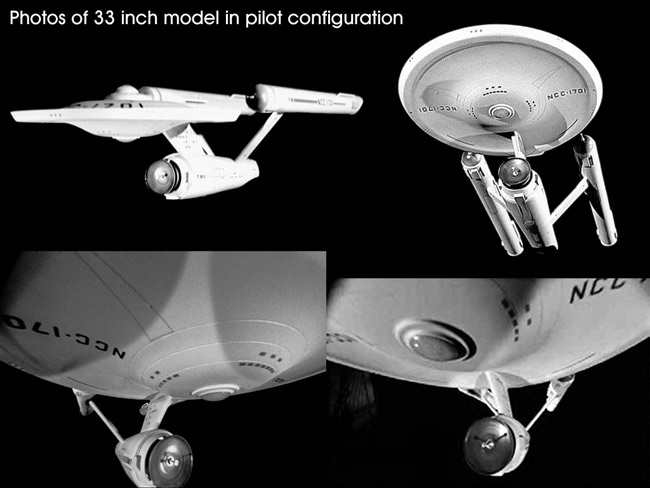 Click to enlarge Dec. 29, 1964 (Tuesday): The 11 foot model (built by Datin, Mel Keys and Vern Sion) was delivered to the Howard A. Anderson studio. This version is unpowered and the windows are painted on the surface of the model... and even at this stage the model was designed to be shot from the right side only (and slightly from the front, rear nacelle details had also been omitted to save time).  Jan. 23, 1965 (Saturday): After The Cage is already in the can and waiting for network approval of the new series, additional test shots of the 11 foot model are taken in it's original configuration.  Click to enlarge Jan. 30, 1965 (Saturday): Aspects of the ship's size (like it being 190,000 tons) were being distributed to the media in the descriptions of the new show. February 1965: NBC declines to include Star Trek in its 1965/1966 programing season. August-September 1965: The 11 foot model is modified to include inner lighting and more surface detail. It doesn't appear that the 33 inch model was modified at this time, but the only noticeable detail that would have been different between them was the rear of the nacelles, and the only shot of the 33 inch model in "Where No Man Has Gone Before" was of it exiting the energy barrier. 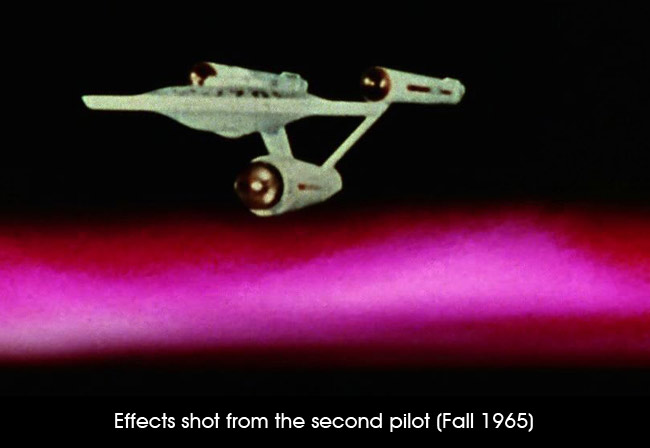 And here are some images of the model in publicity photos (while still in the pilot configuration).  Click to enlarge April 1966: The 11 foot model is further altered for the now approved new series. Some of the previous changes needed to be unmade... the bridge had a large window cut into it and to remove it the bridge was cut in two along the top edge of the window. The top half was returned to the model and the bottom half discarded. Here is some discussions of those changes. Memo on costs from Howard A. Anderson Company... 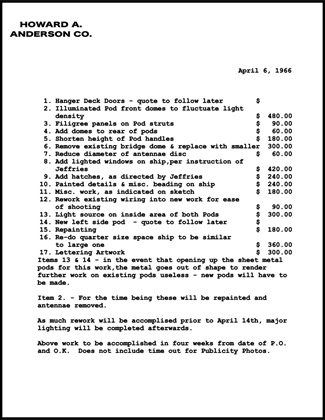 Click to enlarge Memo from Roddenberry discussing the alterations to the models... 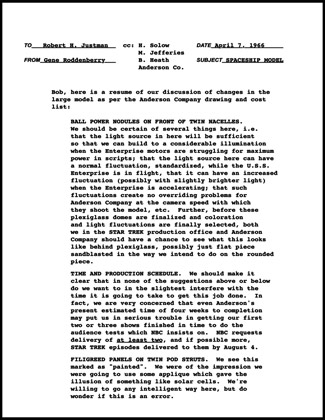 Click to enlarge 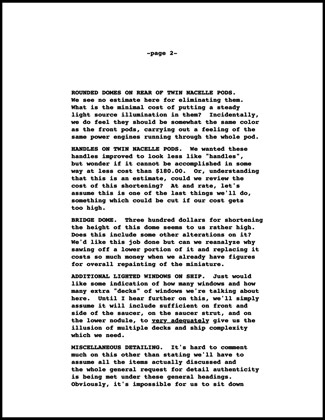 Click to enlarge  Click to enlarge  Click to enlarge The 33 inch model was modified around this time to match the changes to the 11 foot model. This required removal of the nacelles to make some of the alterations. Notably, the bridge was shorten to Jefferies' original specification (not matching the compromised lower bridge of the 11 foot model). September 1966: The unfinished model was pressed into service as a display piece to advertise the show. In the images below the nacelles do not appear to be glued in place and are missing the registry decals (the original painted registry has been removed). 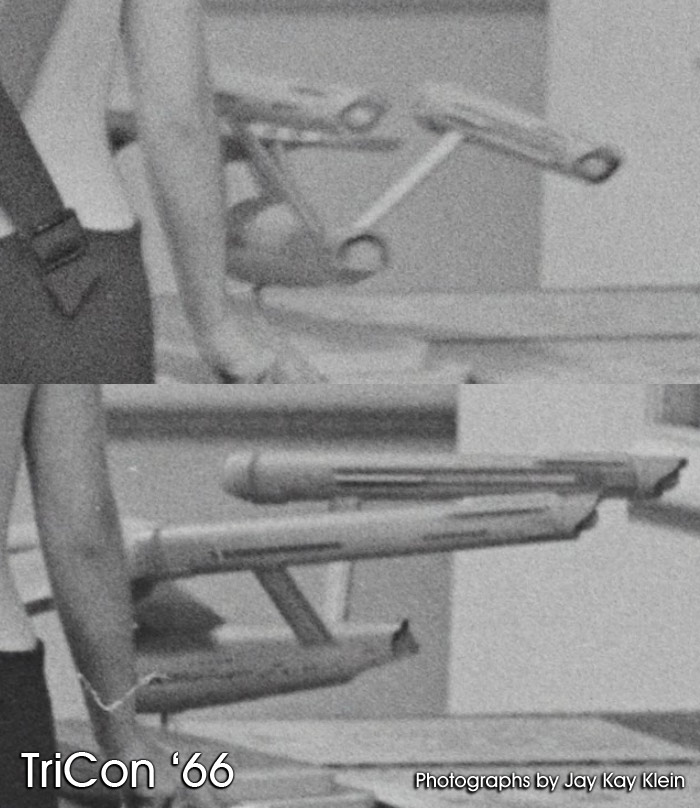 December 1966: Datin completes his final alteration to the 33 inch model, using a microphone stand (a gooseneck arm mount and wooden base) he had so that the model could be easily displayed. Datin said this was the last time he worked on the model. Early 1967: The 33 inch model is used for some effects shots in "Tomorrow is Yesterday." In addition to the shots seen in the episode, the model was photographed in experimental arrangements (most likely to see if blue screen compositing could be avoided). Below is an effects shot from the episode...  Here are some of the additional shots of the model, many of which would be distributed as publicity photos of the Enterprise. 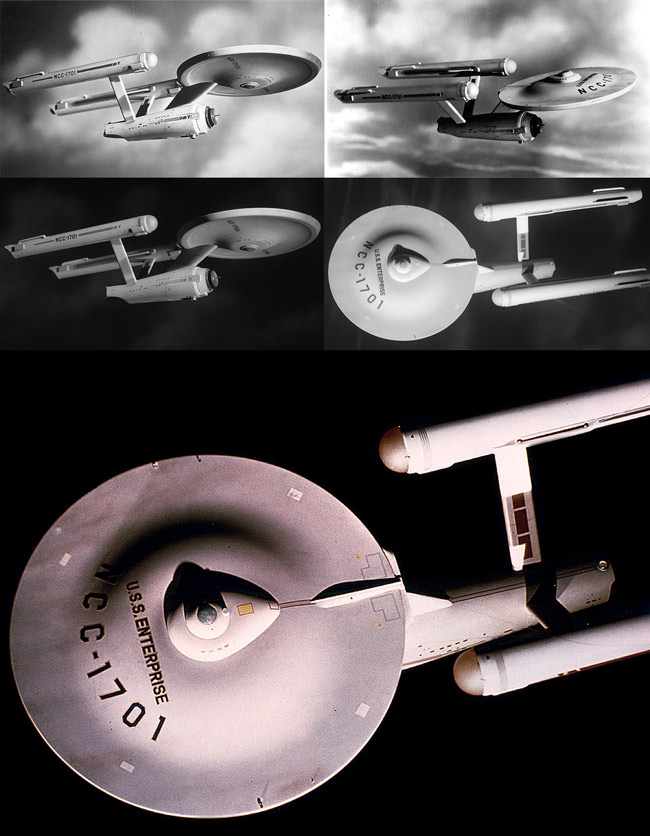 Click to enlarge And some publicity photos of the modified model.  Click to enlarge December 1967: During the second season episode "The Omega Glory" the View-Master photographers came on set to photograph elements for their slide disks. Two of these photos were of the 33 inch model in the foreground with an AMT Model (possibly the one from "The Trouble With Tribbles", but Datin once noted that Jefferies had a number of these kits in his office by this time) in the distance representing the Exeter. One photo was used within the slide presentation, the other was used for the cover of the packaging.  Click to enlarge August/September 1968: The 33 inch model is displayed at BayCon (the 26th World Science Fiction Convention) in Berkeley. Star Trek receives a Hugo Award for "The City on the Edge of Forever" and Roddenberry receives a special award for Star Trek at this event. 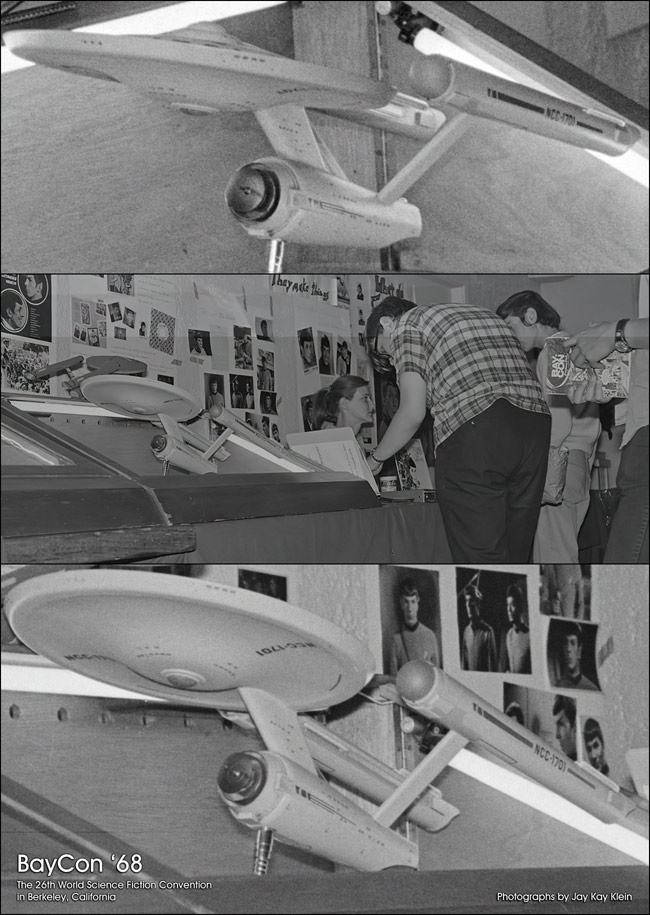 Click to enlarge Between the Second and Third Season of Star Trek: The 33 inch model is damaged, most likely from a fall. Some repairs were made (poorly) and the hangar doors were lost. December 1968: The 33 inch Enterprise appears on a table in "Requiem for Methuselah". As the 11 foot model wasn't filmed again after effects footage done for the second season episode "The Trouble With Tribbles", the 33 inch model was both the first and last to go before the cameras for Star Trek.  Spring 1969: The 33 inch model is photographed for publicity shots for advertising the series. 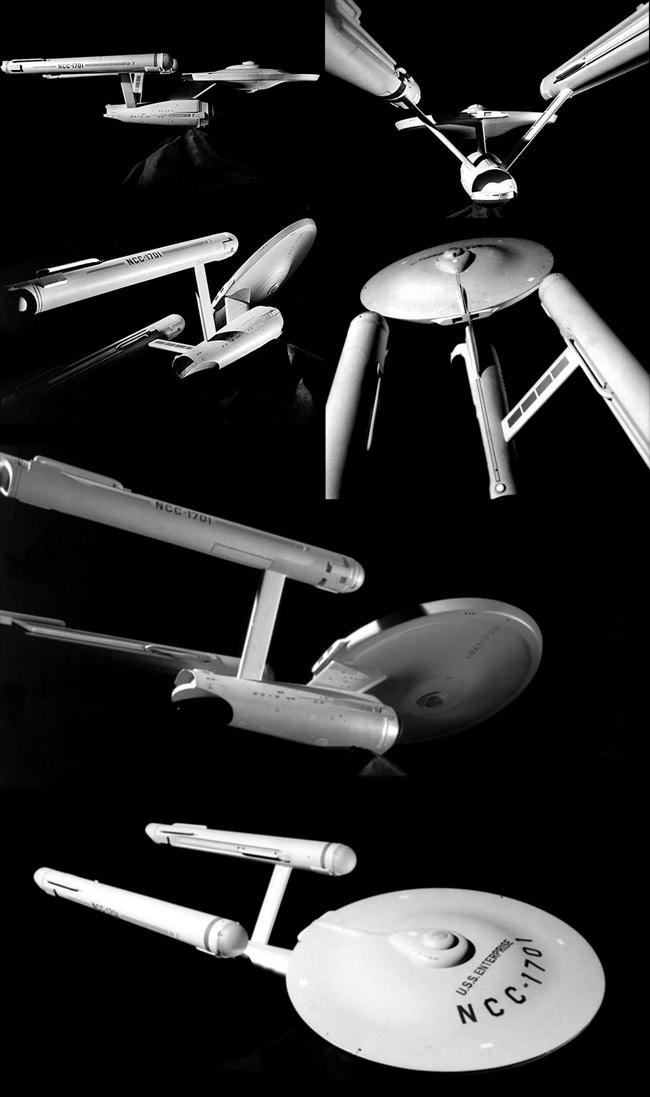 Click to enlarge June 1969: Star Trek ends its network run. 33 inch model is given to Roddenberry (the Klingon model is given to Jefferies, but many of the larger assets, like the 11 foot model, end up in storage). Early 1970s: The 33 inch model follows Roddenberry to be displayed at speaking events. 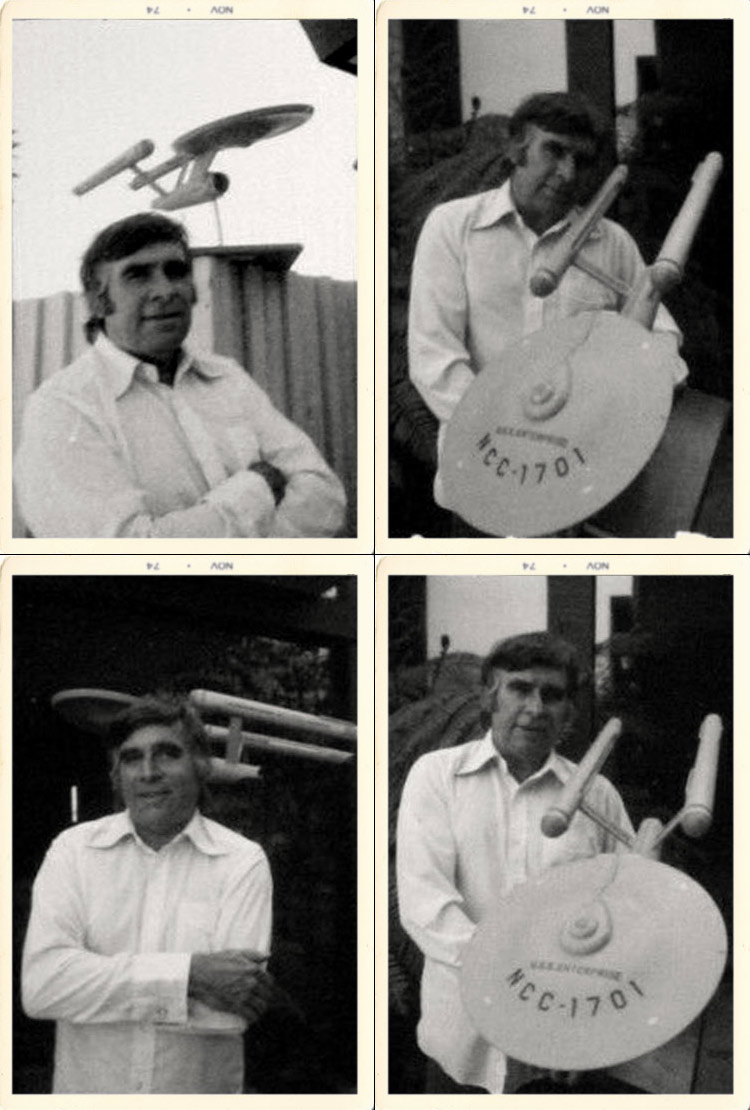 March 1974: The 11 foot model is donated to the Smithsonian Institution. 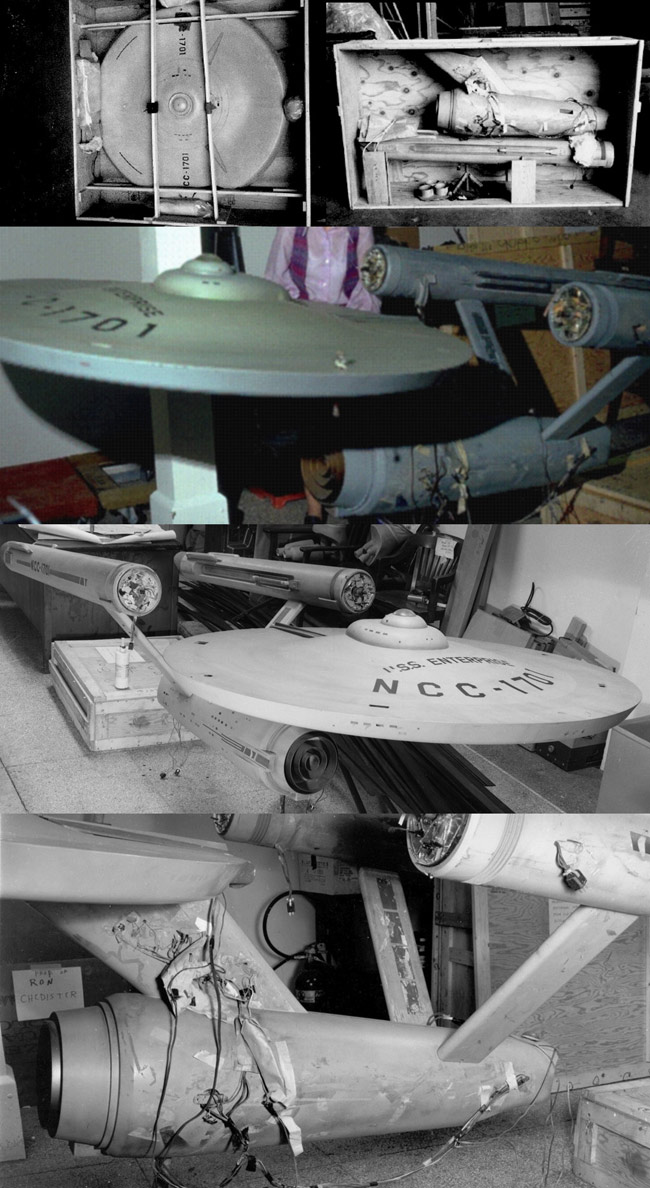 Click to enlarge Sept. 26, 1974: Paramount issues a press release about the donation of the 11 foot model to the Smithsonian Institution.  Click to enlarge 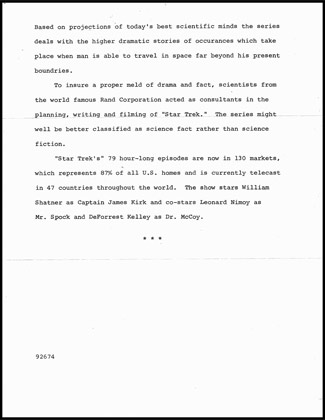 Click to enlarge May 1975: Roddenberry returns to Paramount to start development of a new Star Trek property (at first a movie, then a series, and then back to a movie). The 33 inch model was displayed in Roddenberry's office during this period.  1977: Roddenberry talks Jefferies (who is now the art director for "Little House on the Prairie") into designing the Enterprise for the Star Trek II television series (generally known as Star Trek Phase II because most people associate Star Trek II with the feature film Star Trek II: The Wrath of Khan). In addition to his notes from the original series, Jefferies uses the 33 inch Enterprise as a reference (which was sitting one floor up from his office in Roddenberry's office). Jefferies made sure that both Brick Price Movie Miniatures and Magicam knew that the 33 inch model was to be used as a reference for details (like the color of the Enterprise) and omissions from his plans. Jefferies drafted the final plans for the studio model in his hotel room in the evenings while on location for "Little House on the Prairie." 1978: Roddenberry loaned the 33 inch model to Robert Abel and Associates who were working on Star Trek: The Motion Picture. Roddenberry had requested that Jefferies' design of the Enterprise be the starting point for the movie version. Because Jefferies' drawings were incomplete, providing this information meant including the 33 inch model. The materials were given to Richard Taylor's team by Jon Povill, but I'm not sure that Taylor understood what he was getting. In a 2013 interview he described the Phase II Enterprise this way... "The model that was being built really didnít have that ó I canít remember any lights that were built into it but it was about two and a half, three feet long or something." Not surprising as Taylor wasn't (and still isn't) a fan of Star Trek. February 22, 1979: Taylor and Robert Abel and Associates are released from Star Trek: The Motion Picture. Some of Taylor's team was rehired by Paramount to help with completing the film. The 33 inch Enterprise did not return. Late 1979, early 1980: Roddenberry begins attempts to recover the 33 inch model. No one is sure of who was the last to have been seen with it and the relationship with Robert Abel and Associates was obviously strained at this point. Roddenberry asked for the help of Jeffrey Katzenberg.  Click to enlarge My understanding was that some time after the release of Star Trek: The Motion Picture, Roddenberry asked Bob Abel directly about the model. Abel searched for the model, but was unable to ascertain it's whereabouts. As both Roddenberry and Abel are no longer with us, this was as far as I had pursued the matter. October 2023: A model fitting the description of the 33 inch studio model appears on ebay. Based on my study of the images provided with the auction, I believe this is the actual model. 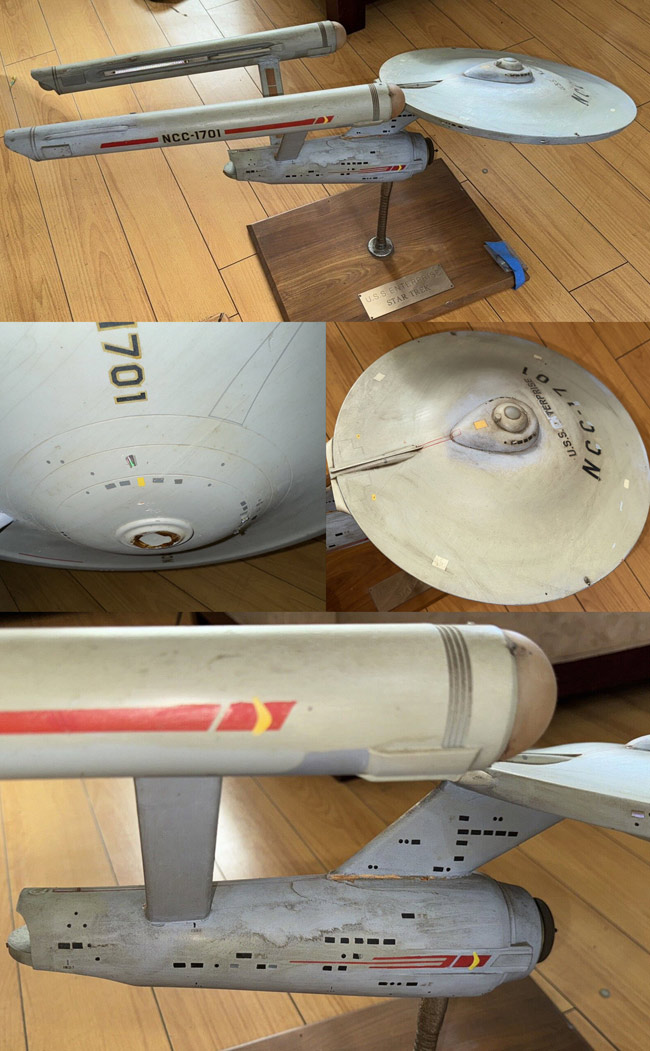 Click to enlarge
From there I spent a little over a month in 2007 doing image studies and drawing up plans of the model and put them together in this set... And upon further review I realized that I had enough information to reverse engineer a skeleton of Matt Jefferies original construction plans (a more fleshed out version is shown in the timeline section) ... Even before I released my 33 inch plans to the public, I knew they were flawed. And I knew that the only way to find the flaws was to build a model (physical or CG) and compare it with my growing collection of images of the original (here, here and here). Between 2007 and 2010 I did just that, building 2 two-thirds scale versions (based on a two-thirds scale printing of my plans) which can be seen here and here. And as I had foreseen, I found lots of little errors and oversights which I corrected in my subsequent versions of those plans.
|

